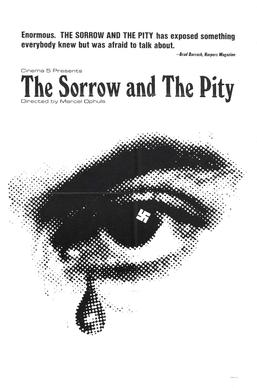
Jean Pierre Moulin was a French civil servant and resistant who succeeded in unifying the main networks of the French Resistance in World War II, a unique act in Europe. He served as the first President of the National Council of the Resistance from 27 May 1943 until his death less than two months later.

Pierre Brossolette was a French journalist, politician and major hero of the French Resistance in World War II.

Maurice Druon was a French novelist and a member of the Académie Française, of which he served as "Perpetual Secretary" (chairman) between 1985 and 1999.

Emmanuel d'Astier de La Vigerie was a French journalist, politician and member of the French Resistance.

The Sorrow and the Pity is a two-part 1969 documentary film by Marcel Ophuls about the collaboration between the Vichy government and Nazi Germany during World War II. The film uses interviews with a German officer, collaborators, and resistance fighters from Clermont-Ferrand. They comment on the nature of and reasons for collaboration, including antisemitism, Anglophobia, fear of Bolsheviks and Soviet invasion, and the desire for power.
Henri d'Astier de La Vigerie was a French soldier, Résistance member, and conservative politician.

José Aboulker was an Algerian Jew and the leader of the anti-Nazi resistance in French Algeria in World War II. He received the U.S. Medal of Freedom, the Croix de Guerre, and was made a Companion of the Liberation and a Commander of the Légion d'honneur. After the war, he became a neurosurgeon and a political figure in France, who advocated for the political rights of Algerian Muslims.

Fernand Bonnier de La Chapelle was a royalist member of the French Resistance during World War II. He assassinated Admiral of the Fleet François Darlan, the former chief of government of Vichy France and the high commissioner of French North Africa and West Africa, on 24 December 1942.

Libération-sud was a resistance group active between 1940-1944 and created in the Free Zone of France during the Second World War in order to fight against the Nazi occupation through coordinated sabotage and propaganda operations.

Henri Krasucki was a French trade-unionist, former secretary general of the General Confederation of Labour (CGT) from 1982 to 1992.
Events from the year 1900 in France.
Maurice Diamant-Berger, known as André Gillois, was a French writer, radio pioneer and - during the Second World War - general Charles de Gaulle's spokesman in London.

Louis-Do de Lencquesaing is a French actor and film director. He has a daughter with cinematographer Caroline Champetier, the actress Alice de Lencquesaing.

Paul Rivière was a French Resistance fighter and politician. He joined the Resistance from 1941 and took part in the Indochina and Algeria Wars.

Élie Lévy LdH, MM, CdG with palm, CdG, (1895-1945) was a French medical doctor who was a member of the French Resistance during the Second World War.
Jean-Baptiste Albert Antoine Biaggi, known to friends as "Bapt", was a French far-right activist, soldier, French Resistance leader, lawyer and politician. He sided with Charles de Gaulle during World War II, welcoming his return from retirement but rejected Gaullisme when Algerian self-determination was granted. He retired from mainstream politics but supported the Front National thereafter.
Maurice Duclos, codename Saint-Jacques, was a French soldier, insurance broker, anti-communist militant activist, intelligence agent and founder of the first French resistance network of WWII, also called Saint-Jacques, and two others.
The Saint-Jacques network was the first French resistance network of World War II. It was founded by Maurice Duclos - whose codename was Saint-Jacques - and operated under the auspices of Charles de Gaulle's Free France in London.
The Orion Network was a French Resistance network during World War II that originated from the la chaine Franco-Belge that was created by Henri d'Astier de La Vigerie and Georges Piron de la Varenne in the autumn of 1940. After being compromised in northern France, it was integrated with the Saint-Jacques network and most operations were moved to the south. Its leaders were at the vanguard of the Allied invasion of Provence.













